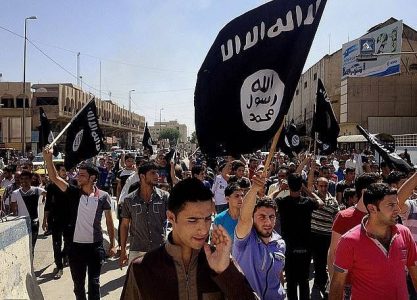
The Islamic State has double the number of soldiers across Iraq and Syria
ISIS has double the number of troops it had when it began capturing territory in Iraq and Syria in 2014 and is poised for a comeback, a Kurdish leader has warned.
Masrour Barzani, prime minister of the autonomous region of Iraqi Kurdistan, issued the stark warning amid moves by President Trump to withdraw US troops from the region after years of fighting.
While ISIS has lost all of its territory and much of its leadership, Barzani believes the terror group still has 20,000 fighters in Iraq and Syria and is trying to recruit more.
That number is double the initial US estimates of ISIS’s strength when it began capturing territory across Iraq and Syria in 2014, sparking an international crisis.
Revised CIA estimates put that number at 31,000, while Iraqi security advisers estimated it had 100,000 fighters by the time it announced the formation of a ‘caliphate’ in July that year.
Nevertheless, Barzani cautions that the modern-day ISIS is still a force to be reckoned with and ‘should not be taken lightly.’
Speaking to The Atlantic, he said: ‘ISIS is still very much intact. Yes, they have lost much of their leadership. They have lost many of their capable men.
‘But they’ve also managed to gain more experience and to recruit more people around them.’
ISIS launched a lightning-fast offensive across Iraq and Syria in 2014, capturing a huge swathe of territory that stretched from Aleppo to the outskirts of Baghdad.
The capture of Iraq’s second city of Mosul, and subsequent declaration of a caliphate by then-leader Abu Bakr al-Baghdadi, saw them rise from an Al Qaeda splinter group to the world’s foremost terror group.
America began a bombing campaign against ISIS in Iraq and Syria in 2014, and began supporting forces on the ground – largely led by the Kurds – in order to push the terror group back.
By early 2016, the US estimated that ISIS had lost 40 per cent of the 36,000 square miles of territory it once held.
The following year ISIS lost the battle for Mosul, its last stronghold in Iraq, shortly before being driven out of Aleppo in Syria.
In March 2019, the terrorist’s last redoubt – a sliver of land called Baghouz in Syria – was captured by Kurdish forces, spelling the end of the group as a territorial power.
Since then ISIS has transformed into a guerrilla fighting force similar to Al Qaeda, directly launching bomb and gun attacks in Syria and Iraq.
The group has also worked to expand its presence in volatile regions of Africa, while using self-radicalised individuals to perpetrate attacks further abroad.
Vladimir Voronkov, undersecretary-general for the U.N. Office of Counter-Terrorism, warned last year that ISIS still commands a $300mllion war chest to fund attacks.
The group ‘continues to evolve into a covert network’ with fighters spread across the Middle East, West Africa, Asia and embedded in western nations, he said.
Source: Daily Mail





